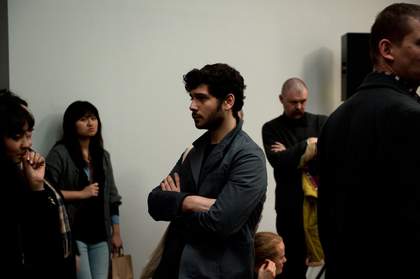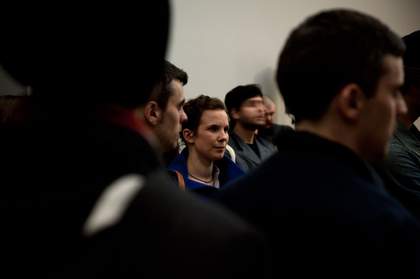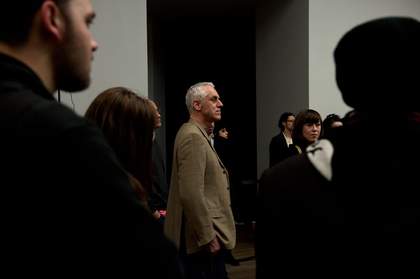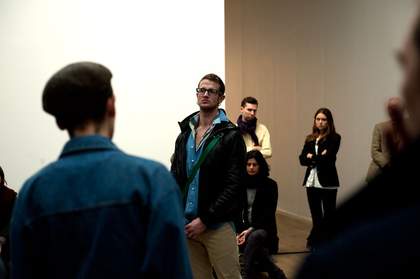Untitled 2011 is a collaborative sound artwork by Mark Leckey and Florian Hecker, which they later recorded and released as an LP. To create this new piece, which focused on sound as a means of exploring how technology mediates everyday life, the duo combined Leckey’s previously presented performance work GreenScreenRefrigeratorAction 2010 with the technique Hecker uses to create his soundscape works and mixed them into a new artwork. Both artists have an interest in the impact of sound on audiences: Leckey is interested in encounters with sounds as cultural object and understanding how humans form relationships with them; for Hecker, sound is a medium to be moulded and experimented with, a means of moving the audience in ways rooted in physical as well as auditory sensation. Combining their approaches to sound and its audience created the ‘chimera’ referenced in the eventual title, Hecker Leckey Sound Voice Chimera.1 This hybrid work drew on each of their individual interests in the nature of sound, and made these present, but also allowed an exploration of their shared interest in the mediation of life through sound and its technologies.
In GreenScreenRefrigeratorAction Leckey inhaled the gases from a black Samsung refrigerator before performing a monologue. Leckey asserted that his monologue would give voice to the machine’s thoughts and render it alive. The machine was set against a green screen backdrop, while Leckey wore a green cloth so that his body disappeared. As such, the artist’s voice seemed to emanate from the refrigerator, which was marketed as ‘smart’ because it could monitor its environment, its contents and (even without a voice) communicate through connections to other electronic devices. Leckey’s performance set up a different biological relationship, transforming its environmental output into a vocalisation, distinct from the digital relationship established by the machine technology.
For Hecker’s contribution to the collaboration he returned to his piece 3 Channel Chronics, which he had presented at Museum Moderner Kunst (MUMOK) in Vienna the previous year. At MUMOK, three telescopic speakers were attached to the ceiling of the gallery, playing synthesised sounds from three different channels. At Tate, three free-standing speakers were used to achieve the same effect. As visitors walked past these speakers, their movements allowed them a manipulated experience of the noise: moving around, they could hear one channel, then another and standing at certain points meant multiple channels could be heard simultaneously. This added a participatory element to the work, as the audience was able to control their own listening experience.
Hecker and Leckey combined these distinct works to create a hybrid or chimera. Hecker described the techniques of doubling, synchronicity and overlapping used in Untitled as an ‘auditory chimera’. The resulting work spliced recordings of Leckey’s monologue with Hecker’s sound manipulation tracks from 3 Channel Chronics. Untitled featured a recognisably human voice overlaid with a robotic, digitized tone, interspersed among more fully computer-synthesised sounds, resulting in a melodic, musical sound. The work was presented in a gallery over the period of one evening. Depending on the visitor’s position in the room, they would experience the sounds in different combinations, with the bodies of other audience members further interrupting and distorting the sounds issuing from the various speakers.
This exhibition of Untitled was followed by a brief presentation by Leckey on the artists’ individual and collaborative practices. He explored the notion of the chimera, looking at the nature and history of hybrid art forms from cinema to the rise of the green screen. The overall piece – the composite work, its experience by the audience, and the artist talk – became an exploration of the ways in which contemporary life is mediated by sound, and how the manipulation and utilisation of sound can become a tool for understanding the relationship between people and technology.
Untitled formed part of Tate Modern Live: Push and Pull (18–19 March 2011). Push and Pull was based on Alan Kaprow’s performance environment Push and Pull: A Furniture Comedy for Hans Hoffman 1963. In this piece, Kaprow installed furniture in two rooms, and allowed the public to rearrange it in accordance with a set of instructions. The subtitle of the piece referred to the painter Hans Hoffman who famously taught many of the most distinguished American artists of the mid-twentieth century, including Kaprow. Hoffman used the phrase ‘push and pull’ to describe how a painter should create movement within a painting using contrasts of colour, form and texture. Kaprow repurposed this phrase from its original application in relation to painting and instead applied it to performance, transposing this theory from the flat canvas into a three-dimensional social space. The event at Tate Modern looked at contemporary artists following this idea of translating theories and concepts across mediums, including Leckey and Hecker, whose piece fuses practices and concepts developed by each artist into a new, hybrid work.
Acatia Finbow
October 2015






